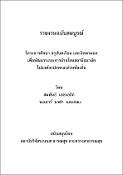บทคัดย่อ
การศึกษาวิจัยครั้งนี้ใช้วิธีการศึกษาผสมผสานทั้งเชิงคุณภาพและเชิงปริมาณ โดยการศึกษาครั้งนี้ เน้นเชิงคุณภาพโดยมีวัตถุประสงค์ เพื่อศึกษาความรู้ความเข้าใจกระบวนการการจัดตั้งกลไก ติดตามผลผลิตผลที่เกิดขึ้นวิเคราะห์และสรุปบทเรียนจัดทําข้อเสนอแนะเชิงนโยบาย กลไก โครงสร้างในการถ่ายโอนสถานีอนามัยไปยังองค์กรปกครองส่วนท้องถิ่น การศึกษาวิจัยได้เริ่มดําเนินการตั้งแต่เดือนกันยายน 2550 ถึงเดือนตุลาคม 2551 ผลการศึกษาวิจัยพบว่า กลไกและกระบวนการในการดําเนินการถ่ายโอนสถานีอนามัยไปยังองค์กรปกครองส่วนท้องถิ่นทุกพื้นที่ที่ถ่ายโอนได้ผ่านกลไกและกระบวนการภายใต้หลักการหลักเกณฑ์ เงื่อนไขต่างๆ ทั้งนี้ยังติดขัดในเรื่องระยะเวลาที่กระชั้นชิด การสื่อสารกับพื้นที่ทุกระดับ ด้านผลผลิต (Product) พบว่า การถ่ายโอนสถานีอนามัยมี 4 รูปแบบ ได้แก่ รูปแบบที่ 1 ถ่ายโอนสถานีอนามัยและบุคลากรมาทั้งหมด รูปแบบที่ 2 ถ่ายโอนสถานีอนามัยมาทั้งหมด บุคลากรมาบางส่วน รูปแบบที่ 3 ถ่ายโอนสถานีอนามัยมาบางแห่ง บุคลากรมาทั้งหมด และรูปแบบที่ 4 ถ่ายโอนสถานีอนามัยและบุคลากรมาบางส่วน แต่ละรูปแบบมีผลให้การตั้งรับการบริหารจัดการงาน เงิน คน วัสดุแตกต่างกัน ผลที่เกิดขึ้น(Output) พบว่า ด้านแนวคิดและกระบวนทัศน์ที่เกี่ยวข้องกับการกระจายอํานาจด้านสุขภาพสู่ท้องถิ่นมีคุณค่าความสําคัญ และมีผลต่อการถ่ายโอนเป็นไปได้อย่างราบรื่นเกิดการมีส่วนร่วม มีการประสานงานกับเครือข่ายสุขภาพอย่างต่อเนื่อง ด้านนโยบาย ยุทธศาสตร์ในพื้นที่มีการวางกลยุทธ์ที่เน้นการสร้างระบบบริการที่เป็นธรรม เร่งสร้างงานเชิงรุกร่วมกับการปรับปรุงนโยบาย ยุทธศาสตร์และแผนกิจกรรมด้านสาธารณสุขและสิ่งแวดล้อมควบคู่กับการพัฒนาโครงสร้างพื้นฐาน และด้านการบริหารจัดการงาน เงิน บุคลากร ทรัพย์สิน วัสดุ ยาและเวชภัณฑ์ไม่ราบรื่นนัก เนื่องจากยังมีความไม่ชัดเจนในกฎระเบียบ ทั้งนี้ปัจจัยที่ช่วยหนุนเสริมให้การถ่ายโอนสถานีอนามัยเป็นไปได้ด้วยดีคือ ความร่วมมือเดิมในการทํางานด้านสุขภาพร่วมกัน ความเป็นผู้นํา มีวิสัยทัศน์ และความสามารถในการบริหารจัดการของฝ่ายบริหารองค์กรท้องถิ่น ปัญหาอุปสรรคที่เกิดขึ้นจากการถ่ายโอนสถานีอนามัยส่วนใหญ่เป็นเรื่องระเบียบของกระทรวงสาธารณสุขและมหาดไทยที่ต้องมีการปรับเข้าหากันในการบริหารจัดการ ข้อเสนอแนะการถ่ายโอนสถานีอนามัยไปยังองค์กรปกครองส่วนท้องถิ่น ระดับนโยบายต่อคณะกรรมการกระจายอํานาจแห่งชาติ กระทรวงสาธารณสุข และมหาดไทย ควรมีนโยบายที่ชัดเจน มีเอกภาพ มีการจัดตั้งศูนย์ประสานงานการถ่ายโอนสถานีอนามัยให้หน่วยงานกลาง จัดทําสื่อประชาสัมพันธ์เผยแพร่สู่สาธารณะในช่วงเตรียมความพร้อมที่เน้นคุณค่า อุดมการณ์ และผลดีของการกระจายอํานาจด้านสุขภาพสู้ท้องถิ่น ระดับจังหวัดและอําเภอในการสนับสนุนการถ่ายโอนสถานีอนามัย ควรมีการจัดตั้งกลไกทางวิชาการที่มีส่วนร่วมจากทุกฝ่าย เพื่อติดตามหนุนเสริมกระบวนการชี้แจงสร้างความเข้าใจแก่ทุกฝ่ายอย่างเพียงพอระหว่างและหลังการถ่ายโอนควรมีการแลกเปลี่ยนเรียนรู้ร่วมกัน ระดับพื้นที่ต่อองค์กรปกครองส่วนท้องถิ่นและสถานีอนามัย การตัดสินใจในการถ่ายโอน การสนับสนุนการจัดทําแผนพัฒนาสุขภาพควรเน้นการมีส่วนร่วมจากทุกฝ่ายที่เกี่ยวข้องตั้งแต่ระดับองค์กรท้องถิ่นจนถึงภาคประชาชน
บทคัดย่อ
This study employs both qualitative and quantitative methods. It aims to understand the process of the transfer system of a public health center (PHC) to Local Government Organization (LGO). Specifically, the study focuses on the process of setting up the transfer mechanism, monitors the product and output, analyzes and summarizes lessons learned, as well as provides policy recommendations relating to the mechanism and structure for transferring the PHC to the LGO. The research duration is from September 2007 to October 2008.
Research results confirm that those PHC under study followed the mechanism and process of the transfer system to LGO. However, they encountered some difficulties pertinent to time constraints and communication problems at all levels. With respect to the product, we have discovered that there were four types of the transfer system: these are (๑) the whole transfer of PHC and personel, (๒) the whole transfer of PHC and parts of personel, (๓) the transfer of some PHC with all personel of those PHC, (๔) the transfer som PHC with parts of personel, of which the majority of the PHC employed the second type. Different types impacted the management of works, budget, personnel and materials differently. Relating to the output, we have learnt that ideas and paradigms of the public health decentralization to local areas were significant and made the transfer system efficient through generating people’s participation and coordinating with the network of public health consistently. In terms of policy and development strategy implemented at the local level, we have discovered that they emphasized the idea of service to all, stimulated proactive works, and improved policy, strategy and planning for public health and environment activities parallel to the development of infrastructure. Also, we have discovered some problems relating to the management of works, budget, personnel, property, material, medicine and medical supplies following the imprecision of rules and regulations from the Ministry of Public Health and the Ministry of Interior. Factors contributed to the success of the transfer included cooperation, leadership ability, having organizational vision and ability for management of the LGO.
Recommendations for transferring the PHC to the LGO are in the following. At the policy level, the national decentralization committee should have a clear integrated policy and establish a national coordinating body to be responsible for making the public known of the value, idea and benefit of the public health decentralization. At the provincial and district level, it is necessary to have a proper academic supporting mechanism based on the participation of all parties concerned for monitoring and supporting the transfer of the PHC to the LGO smoothly and communicate with all concerned parties efficiently. During and after the transfer, it is significant to promote a sharing of experience, information and reflection of the transfer. At the community level, we suggest that the LGO and the PHC should abide by the principle of people’s participation starting from local public organizations to local civil societies in decision making for the transfer of the PHC to the LGO and the support for community health development planning.


